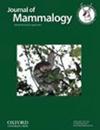性别和年龄调节了森林食肉动物——雪貂(Pekania pennanti)快速环境变化的影响。
IF 1.5
3区 生物学
Q2 ZOOLOGY
引用次数: 0
摘要
快速的环境变化——气候、土地利用和生物相互作用——正在加速全球物种灭绝和灭绝。确定威胁种群的驱动因素对保护至关重要,但由于生物体对生物和非生物压力源的反应具有可变性,因此可能很困难。我们分析了一组长期监测数据,以探索美国加利福尼亚州内华达山脉南部渔民(Pekania pennanti)对快速环境变化的人口统计学响应。Fisher存活率对生物和非生物因素都很敏感,尽管这些影响的强度和方向最终由年龄和性别介导。具体来说,年轻个体中的雄性存活率较低,并且随着温度和真菌消耗的增加而降低。雌性成活率对年龄和饮食有弹性,但随着森林异质性的增加而增加,随着温度和雪深的增加而降低。我们的研究结果表明,持续的气候变化可能会通过增量压力源和极端天气事件对渔民产生影响,但森林异质性的增加可能有助于缓冲这种变化的影响。此外,我们说明了内在和外在因素对生存的影响的重要性,特别是在具有明显性别或个体发生差异的物种中。随着全球环境变化驱动因素的强度和频率不断增强,了解这些复杂的关系将使从业者能够最好地同时管理人口持续性和栖息地恢复力。本文章由计算机程序翻译,如有差异,请以英文原文为准。
Sex and age mediate the effects of rapid environmental change for a forest carnivore, the Fisher (Pekania pennanti)
Rapid environmental changes—in climate, land use, and biotic interactions—are accelerating species extinctions and extirpations globally. Identifying drivers that threaten populations is essential for conservation yet can be difficult given the variable nature of the response of an organism to biotic and abiotic stressors. We analyzed a long-term monitoring data set to explore demographic responses of fishers (Pekania pennanti) to rapid environmental change in the southern Sierra Nevada, California, United States. Fisher survival was sensitive to both biotic and abiotic factors, although the strength and direction of these effects were ultimately mediated by age and sex. Specifically, male survival was lower among young individuals and decreased with increasing temperatures and fungi consumption. Female survival was resilient to age effects and diet but increased with greater forest heterogeneity and decreased with increasing temperatures and snow depth. Our findings suggest that continued climate change will likely have consequences for fishers through both incremental stressors and extreme weather events, but increasing forest heterogeneity may help to buffer against the impacts of such change. Further, we illustrate the importance of disentangling the effects of intrinsic and extrinsic factors on survival, especially among species with distinct sexual or ontogenetic differences. As global drivers of environmental change intensify in strength and frequency, understanding these complex relationships will allow practitioners to best manage for population persistence and habitat resilience concurrently.
求助全文
通过发布文献求助,成功后即可免费获取论文全文。
去求助
来源期刊

Journal of Mammalogy
生物-动物学
CiteScore
3.30
自引率
5.90%
发文量
106
审稿时长
4-8 weeks
期刊介绍:
Papers are published on mammalian behavior, conservation, ecology, genetics, morphology, physiology, and taxonomy.
 求助内容:
求助内容: 应助结果提醒方式:
应助结果提醒方式:


